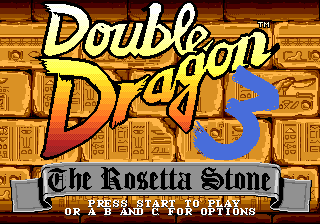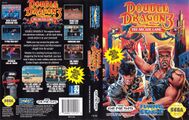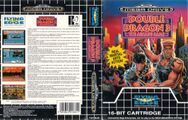Difference between revisions of "Double Dragon 3: The Rosetta Stone"
From Sega Retro
(→Arcade Version Differences: Expanded section with more accurate information, although it might be a bit too comprehensive. The previous edit was inaccurate. The Genesis version is worse, generally speaking.) |
|||
| Line 24: | Line 24: | ||
There are five levels available. This includes America, China, Japan, Italy, and Egypt. | There are five levels available. This includes America, China, Japan, Italy, and Egypt. | ||
| − | == | + | ==Version differences== |
| − | + | * The arcade version of ''Double Dragon 3'' featured item shops where players could gain additional moves, weapons and other playable characters by using real money. These item shops were retained in the Genesis version, but the player is given 15 virtual coins to spent from the outset (which can be raised to 20 or 25 in the options screen), as well as change the starting character for both players (they cannot be chosen individually). The virtual coins can also be used as extra lives for the Lee brothers. More coins are are added to the player's funds after completing each mission. | |
| + | * The purchasable items work differently in the Genesis version. | ||
| + | ** In the arcade version, "energy" restores the player's health to 150%, while "power up" increases the player's movement speed. In the Genesis version, the "energy" item was removed, but "power up" serves the same purpose. However, instead of restoring the player's health to 150%, it restores the player's health to 100% and adds 50 HP more. | ||
| + | ** Both versions allow the player to purchase a stock of up to three extra fighters. However, the arcade version allows the player to have different character types in reserve, while the Genesis version only allows one character type at a time. This means that if the player is controlling a Lee brother and the first extra fighter purchased is a Chin brother, every additional extra fighter will be a Chin until the player runs out of extra fighters and returns as a Lee brother. | ||
| + | * The name of the second Oyama brother was changed from Kunio to Nunio. | ||
| + | * The starting HP for each character type are distributed differently. In the arcade version, the Lee and Oyama brothers started with 230 HP, the Urquidez brothers started with 270 and the Chin Brothers with 290 HP. In the Genesis version, the Lee brothers start with 250 HP, the Urquidez brothers start with 225, the Chin brothers with 300 and the Oyama brothers 375. The damage data for both, player and enemy attacks, are also different. | ||
| + | * The animation frames for consecutive attacks and running are missing in the Genesis version. The belly-to-back throw was removed as well. The enemies also lack their "stun" poses, leading to a much harder difficulty than the arcade version. | ||
| + | * In the arcade version, the hurricane kick is performed by doing a neutral jump and pressing the kick, while the jumping throw is performed by pressing the punch button while jumping over an enemy. In the Genesis version, both of these moves are performed by holding down the d-pad up or down and pressing the C button near an enemy. | ||
| + | * The two co-operative moves (the back-to-back hurricane kick and the triangle jump kick) were removed in the Genesis version. | ||
| + | * The arcade version have multiple music tracks for each mission for different areas and situations (including boss battles). In the Genesis version, there's only one track for each mission. | ||
==Promotional Material== | ==Promotional Material== | ||
Revision as of 19:02, 8 October 2014
| Double Dragon 3: The Rosetta Stone | |||||
|---|---|---|---|---|---|
| System(s): Sega Mega Drive, Sega Master System | |||||
| Publisher: Flying Edge | |||||
| Developer: Technos ( Software Creations) | |||||
| Genre: Action | |||||
| Number of players: 1-2 | |||||
|
This short article is in need of work. You can help Sega Retro by adding to it.
Double Dragon 3: The Rosetta Stone is a 1991 arcade beat-'em-up by Technos; it was ported by Software Creations to the Sega Mega Drive and published in 1992/1993 by Flying Edge. Although the boxart refers to the game as Double Dragon 3: The Arcade Game, the title screen remains the same as the arcade version.
Gameplay
The purpose of the game is to collect three "Rosetta Stones" in order to face off with an adversary in Egypt. The Lee brothers and other characters must travel the world to reach this objective. ![]() punches,
punches, ![]() jumps,
jumps, ![]() kicks. Besides the ability to run by double tapping in a direction additional moves can be bought in a in-game store. The in-game store, which can be entered through a door in certain parts of a level, offers extra moves, extra characters, agility, energy, and weapons for purchase with coins. The extra characters only appear when the main character presently being used is killed. Extra characters include the Urquidez brothers, the Chin brothers, and the Oyama brothers.
kicks. Besides the ability to run by double tapping in a direction additional moves can be bought in a in-game store. The in-game store, which can be entered through a door in certain parts of a level, offers extra moves, extra characters, agility, energy, and weapons for purchase with coins. The extra characters only appear when the main character presently being used is killed. Extra characters include the Urquidez brothers, the Chin brothers, and the Oyama brothers.
Levels
There are five levels available. This includes America, China, Japan, Italy, and Egypt.
Version differences
- The arcade version of Double Dragon 3 featured item shops where players could gain additional moves, weapons and other playable characters by using real money. These item shops were retained in the Genesis version, but the player is given 15 virtual coins to spent from the outset (which can be raised to 20 or 25 in the options screen), as well as change the starting character for both players (they cannot be chosen individually). The virtual coins can also be used as extra lives for the Lee brothers. More coins are are added to the player's funds after completing each mission.
- The purchasable items work differently in the Genesis version.
- In the arcade version, "energy" restores the player's health to 150%, while "power up" increases the player's movement speed. In the Genesis version, the "energy" item was removed, but "power up" serves the same purpose. However, instead of restoring the player's health to 150%, it restores the player's health to 100% and adds 50 HP more.
- Both versions allow the player to purchase a stock of up to three extra fighters. However, the arcade version allows the player to have different character types in reserve, while the Genesis version only allows one character type at a time. This means that if the player is controlling a Lee brother and the first extra fighter purchased is a Chin brother, every additional extra fighter will be a Chin until the player runs out of extra fighters and returns as a Lee brother.
- The name of the second Oyama brother was changed from Kunio to Nunio.
- The starting HP for each character type are distributed differently. In the arcade version, the Lee and Oyama brothers started with 230 HP, the Urquidez brothers started with 270 and the Chin Brothers with 290 HP. In the Genesis version, the Lee brothers start with 250 HP, the Urquidez brothers start with 225, the Chin brothers with 300 and the Oyama brothers 375. The damage data for both, player and enemy attacks, are also different.
- The animation frames for consecutive attacks and running are missing in the Genesis version. The belly-to-back throw was removed as well. The enemies also lack their "stun" poses, leading to a much harder difficulty than the arcade version.
- In the arcade version, the hurricane kick is performed by doing a neutral jump and pressing the kick, while the jumping throw is performed by pressing the punch button while jumping over an enemy. In the Genesis version, both of these moves are performed by holding down the d-pad up or down and pressing the C button near an enemy.
- The two co-operative moves (the back-to-back hurricane kick and the triangle jump kick) were removed in the Genesis version.
- The arcade version have multiple music tracks for each mission for different areas and situations (including boss battles). In the Genesis version, there's only one track for each mission.
Promotional Material
- DoubleDragon3 MD US PrintAdvert.jpg
US print advert
Physical Scans
| Sega Retro Average | ||||||||||||||||||||||||||||||||||||||||||||||||||||||||||||||||||||||||||||||||||||||||||||||
|---|---|---|---|---|---|---|---|---|---|---|---|---|---|---|---|---|---|---|---|---|---|---|---|---|---|---|---|---|---|---|---|---|---|---|---|---|---|---|---|---|---|---|---|---|---|---|---|---|---|---|---|---|---|---|---|---|---|---|---|---|---|---|---|---|---|---|---|---|---|---|---|---|---|---|---|---|---|---|---|---|---|---|---|---|---|---|---|---|---|---|---|---|---|---|
|
| 44 | |
|---|---|
| Based on 18 reviews | |
| Double Dragon games for Sega systems | |
|---|---|
| Double Dragon (1988) | |
| Double Dragon II: The Revenge (1991) | Double Dragon (1992) | Double Dragon 3: The Rosetta Stone (1992/1993) | Battletoads/Double Dragon: The Ultimate Team (1993) | Double Dragon V: The Shadow Falls (1994) | |
| Double Dragon (1993) | |
- ↑ File:SegaForce14UK.pdf, page 14
- ↑ 1700 igr dlya Sega, "" (RU; 2001-xx-xx), page 94
- ↑ Aktueller Software Markt, "August 1993" (DE; 1993-07-12), page 136
- ↑ Cool Gamer, "9" (RU; 2002-10-13), page 67
- ↑ Electronic Games (1992-1995), "March 1993" (US; 1993-02-09), page 70
- ↑ GamePro, "February 1993" (US; 1993-xx-xx), page 50
- ↑ Joypad, "Octobre 1993" (FR; 1993-xx-xx), page 163
- ↑ Sega Mega Drive Advanced Gaming, "May 1993" (UK; 1993-xx-xx), page 38
- ↑ Mega Force, "Septembre 1993" (FR; 1993-0x-xx), page 119
- ↑ Mega Fun, "05/93" (DE; 1993-0x-xx), page 63
- ↑ Player One, "Octobre 1993" (FR; 1993-xx-xx), page 153
- ↑ Play Time, "6/93" (DE; 1993-05-05), page 101
- ↑ Sega Power, "March 1993" (UK; 1993-02-04), page 28
- ↑ Sega Pro, "February 1993" (UK; 1993-01-14), page 42
- ↑ Sega Pro, "April 1993" (UK; 1993-03-11), page 65
- ↑ Sega Zone, "January 1993" (UK; 1992-12-xx), page 64
- ↑ Sega Force, "February 1993" (UK; 1993-01-14), page 14
- ↑ Supergame, "Maio 1993" (BR; 1993-05-xx), page 17
- ↑ Tricks 16 bit, "Tricks Sega Gold 800 igr" (RU; 1998-03-20), page 53
- Pages with broken file links
- 1-2 player games
- Use romtable template
- All games
- Stubs
- Old-style rating (joypad)
- Rating without PDF source
- Old-style rating (mdag)
- Old-style rating (playerone)
- Old-style rating (segapower)
- Old-style rating (segapro)
- Old-style rating (segazuk)
- Old-style rating (sfuk)
- Use magref
- Update ratings template
- 8 old ratings
- Double Dragon (franchise)



